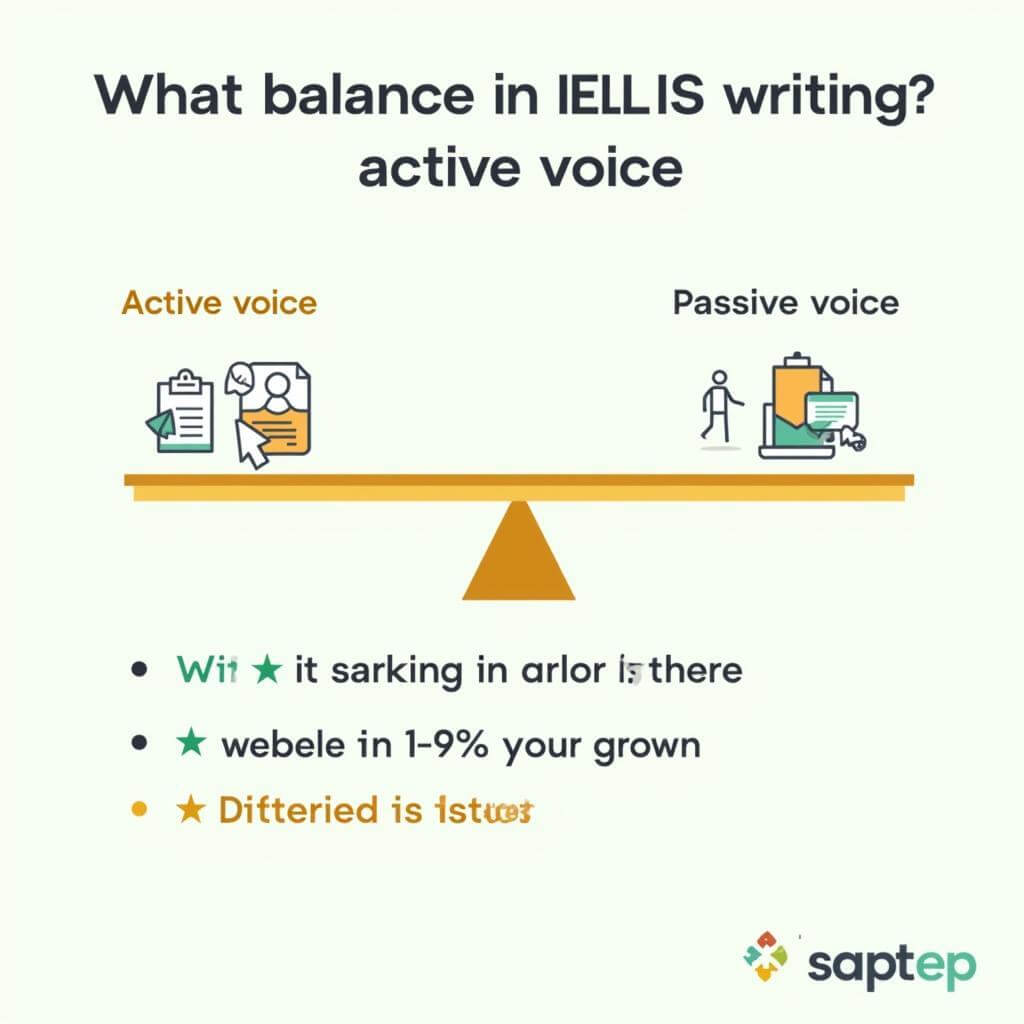In IELTS writing, the active voice is a powerful tool for clear and concise communication. While the passive voice has its place, overusing it can lead to wordy, unclear sentences that may lower your score. Let’s explore effective strategies for avoiding passive voice overuse and enhancing your writing skills for the IELTS exam.
Understanding Active vs. Passive Voice
Before diving into strategies, it’s crucial to understand the difference between active and passive voice:
- Active voice: The subject performs the action (e.g., “The student wrote the essay.”)
- Passive voice: The subject receives the action (e.g., “The essay was written by the student.”)
While both forms are grammatically correct, active voice often creates more direct and engaging sentences, which is particularly important in IELTS writing.
Why Avoid Overusing Passive Voice in IELTS Writing?
- Clarity: Active voice generally provides clearer, more straightforward communication.
- Conciseness: Active sentences are often shorter, helping you stay within word limits.
- Engagement: Active voice creates a more dynamic and engaging writing style.
- Task Achievement: Using active voice can help you address the task more directly.
Dr. Sarah Thompson, a renowned IELTS examiner, notes: “Candidates who effectively balance active and passive voice tend to score higher in Task Achievement and Coherence and Cohesion.”
improving sentence clarity with grammar
Strategies for Avoiding Passive Voice Overuse
1. Identify the Main Actor
When constructing sentences, ask yourself, “Who or what is performing the action?” This will help you naturally form active sentences.
Example:
- Passive: The decision was made by the committee.
- Active: The committee made the decision.
2. Use Strong Verbs
Strong, action-oriented verbs can help you create more dynamic active sentences.
Example:
- Passive: The experiment was conducted by the scientists.
- Active: The scientists conducted the experiment.
3. Rearrange Sentence Structure
Often, you can transform passive sentences into active ones by simply rearranging the word order.
Example:
- Passive: The report was submitted by the team.
- Active: The team submitted the report.
improving grammar in IELTS writing
4. Be Specific About the Subject
Sometimes, passive voice is used when the subject is unclear. In IELTS writing, being specific can help you avoid this issue.
Example:
- Passive: It is believed that climate change is accelerating.
- Active: Scientists believe that climate change is accelerating.
5. Use Active Voice in Topic Sentences
Start your paragraphs with clear, active topic sentences to set a strong tone for your writing.
Example:
- Passive: Environmental issues are being addressed by many countries.
- Active: Many countries are addressing environmental issues.
When to Use Passive Voice in IELTS Writing
While it’s important to avoid overusing passive voice, there are situations where it can be appropriate:
- When the actor is unknown or unimportant
- To emphasize the action rather than the actor
- In scientific writing, where objectivity is key
Professor James Liu, an IELTS writing expert, advises: “Use passive voice sparingly and intentionally. It should serve a specific purpose in your writing, not be a default choice.”
using advanced grammar for higher scores

Practical Exercises for Improving Active Voice Usage
- Rewrite passive sentences: Practice transforming passive sentences into active ones.
- Analyze model essays: Study high-scoring IELTS essays and note their use of active voice.
- Self-edit: Review your own writing and challenge yourself to reduce passive constructions.
- Peer review: Exchange essays with a study partner and provide feedback on voice usage.
improving task 1 report clarity
Common Pitfalls to Avoid
- Overcompensating: Don’t force active voice where passive is more appropriate.
- Ignoring context: Consider the purpose and tone of your writing when choosing voice.
- Neglecting variety: While favoring active voice, remember that some variation can enhance your writing style.
Conclusion
Mastering the use of active voice is a key strategy for improving your IELTS writing score. By understanding when and how to use active voice effectively, you can create clearer, more engaging essays that better demonstrate your language skills. Remember, the goal is not to eliminate passive voice entirely, but to use it judiciously and purposefully.
using grammar for accurate descriptions
Practice these techniques regularly, and you’ll find your writing becoming more dynamic and impactful. As you prepare for your IELTS exam, focus on developing a natural, balanced writing style that showcases your ability to communicate effectively in English.
FAQs About Avoiding Passive Voice Overuse in IELTS Writing
-
Q: How can I quickly identify passive voice in my writing?
A: Look for forms of “to be” (is, was, were) followed by a past participle. For example, “was written” or “is being considered.” -
Q: Is it ever acceptable to use passive voice in IELTS writing?
A: Yes, passive voice can be appropriate in certain situations, such as when the actor is unknown or when you want to emphasize the action over the actor. -
Q: Will using only active voice improve my IELTS score?
A: While active voice often improves clarity, a mix of active and passive voice, used appropriately, can demonstrate linguistic flexibility and boost your score. -
Q: How can I practice identifying and correcting passive voice?
A: Read articles or essays critically, highlighting passive constructions. Then, try rewriting them in active voice to see how it changes the sentence’s impact. -
Q: Are there any IELTS writing tasks where passive voice is more acceptable?
A: In Task 1 reports, especially when describing processes or procedures, passive voice may be more common and acceptable. -
Q: Can overusing active voice make my writing seem too informal?
A: Not necessarily. Active voice can be used in formal writing as well. The key is to maintain an appropriate tone through your word choice and sentence structure.